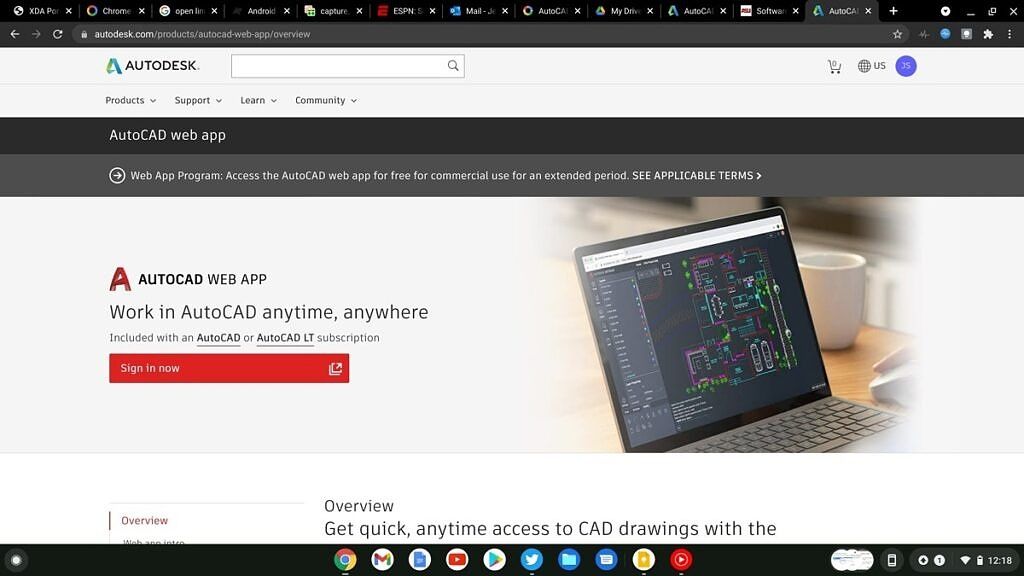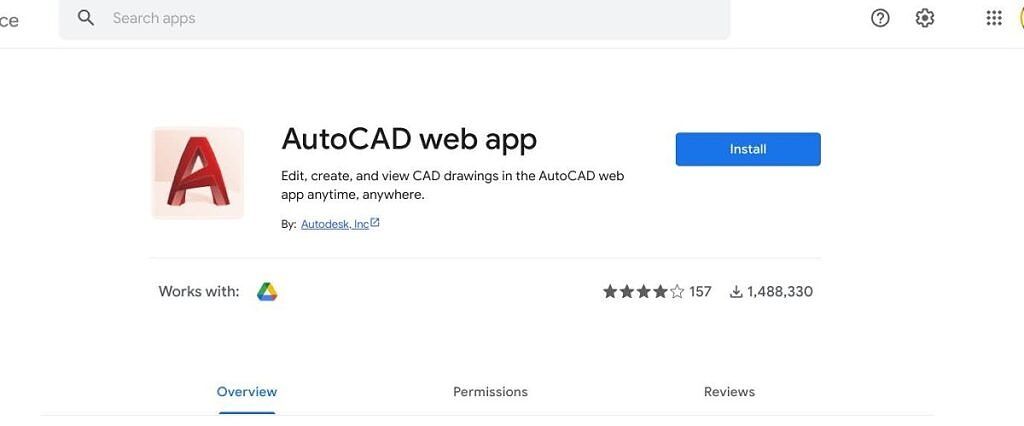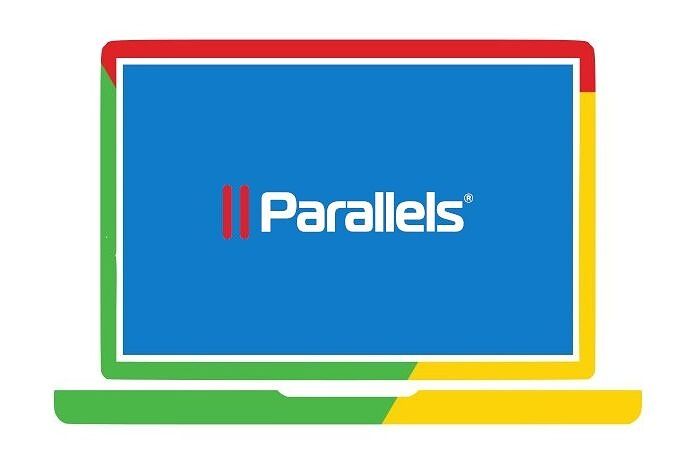It’s a common misconception that Chromebooks aren’t capable of running powerful software found on PCs or Macs. If you’re an engineering student, you might need to run some fairly intensive applications on your laptop. Chromebooks are a great solution for students because they’re secure and cost-effective.
If you’re an engineering student using a Chromebook, you probably need to run AutoCAD for some of your course assignments. Unlike on a PC, AutoCAD doesn’t offer a native ChromeOS installation. Luckily, there are still a few easy ways to take advantage of AutoCAD’s drafting power on a Chromebook or other ChromeOS device. We’ll take a look at the online version of AutoCAD for students, as well as discuss how to run the full version of AutoCAD using Parallels for enterprise customers.
Run AutoCAD on a Chromebook using the browser
If you only need AutoCAD for very basic tasks, like an introductory engineering or drafting course, your best bet is running AutoCAD in the browser or using the Progressive Web App (PWA). AutoCAD offers a robust online platform for cloud computing with a fair amount of power.
To use AutoCAD online you only need to log in to your university or organization’s AutoDesk account and choose the online option. If you’re already signed in to your AutoDesk account, you can access the online platform directly via web.autocad.com.
The main downside to using AutoCAD online is that you must store files in the cloud. Thankfully, AutoCAD makes it easy to integrate any cloud service you desire with their web app. This is in stark contrast to the case with MATLAB online. Inside the AutoCAD web app, you can choose Dropbox, Box, OneDrive, Google Drive, and others as your primary cloud storage service. This option makes it much easier to work with AutoCAD in the browser for assignments and collaborative projects.
Speed in the browser is honestly quite impressive. AutoCAD runs flawlessly in the web app for most 2D design tasks. There is a small bit of lag if you try more advanced 3D drafting, but that’s to be expected. Features found in the web app include:
- Edit geometry and select, move, rotate, and scale objects within drawings through your choice of the ribbon or command line.
- Access easy-to-use drafting tools and manage views, properties, and layers. Reduce eyestrain with sharp icons and a modern blue interface.
- Safely review and add feedback directly to a DWG file without altering the existing drawing.
- Send a controlled copy of your drawing to teammates and colleagues to access wherever they are.
- View, edit, share, and save drawings stored in Autodesk Drive and Autodesk Docs, as well as in OneDrive, Google Drive, Dropbox, and Box.
- Easily access the command line, which is docked in the bottom left of the drawing area and displays prompts, options, and messages.
- Take measurements and add dimensions to your drawings.
To be sure, there are few advanced rotation and manipulation features only found in the PC version of AutoCAD, but the web app’s capability is impressive overall.
Use AutoCAD extensions for ChromeOS
For those planning to use the AutoCAD app frequently, you may also want to add a shortcut to the web app in your Chromebook’s app drawer. You can also install a Google Drive extension for the AutoCAD web app via the Google Workspace Marketplace. This allows you to integrate AutoCAD directly with Google Drive. With this extension installed, you can use the ‘Open with’ option in Drive by right-clicking to open files directly in AutoCAD.
Obviously, it’s much nicer to use a local copy of AutoCAD on a PC, which has additional features and local file storage. Still, for students using AutoCAD on assignments, this should get the job done. You can always choose to move files back and forth between AutoCAD’s cloud storage and your own Google Drive or Dropbox folder. Obviously, this isn’t ideal, but it can get the job done in a pinch. If you have an LTE Chromebook, make sure to turn off auto-sync for cloud services in AutoCAD.
Run AutoCAD on a Chromebook using Parallels Desktop
For those that can’t make do with the online solution, there’s another convenient option if you’re an enterprise or education customer. It’s possible to install the Windows version of AutoCAD using Parallels Desktop for ChromeOS.
Parallels Desktop is a full-featured Windows container that runs natively on ChromeOS. This software allows you to run the full version of Windows, but there are a few important things to be aware of.
The Parallels Desktop software is currently only available at scale to business customers, making this option of little use to individual users at the present time. With Parallels Desktop for Chrome OS, IT departments can enable proprietary and full-featured Windows applications — including AutoCAD — on Chrome OS devices, online and offline. You’ll need a Chrome Enterprise upgrade to run Parallels. Some key features of Parallels Desktop for ChromeOS include:
- Always-on access to business-critical Windows apps
- Effortlessly switch between ChromeOS and Windows – no need to reboot.
- Suspend and resume Windows to instantly get back up and running.
- Open files on ChromeOS using Windows applications.
- BONUS: Access 30+ one-touch tools with included Parallels Toolbox.
- Utilize full feature sets of desktop applications including Word, Excel, PowerPoint, and more.
- Access Windows Desktop, Documents, Downloads, and custom folders from Chrome OS files.
- No internet? No problem! Files and apps are fully accessible both online and offline.
- Easily move content between Chrome OS and Windows via a shared clipboard.
- Print from Windows to supported printers.
- Stay in the flow with a seamless mouse, camera, microphone, audio & docking plus USB smart card reader support.
- Enjoy the view with dynamic resolution and full-screen support.
Requirements for running Parallels Desktop
There are minimum system requirements to run Parallels on your Chromebook. You need at least ChromeOS version 85 or later. Additionally, you need the Google Admin console, Chrome Enterprise Upgrade/Chrome Education Upgrade, a Microsoft Windows ISO, a Windows license, and a storage server if you wish to distribute to multiple machines in your organization. In terms of hardware, supported processors include Intel Core i5 or i7 and AMD Ryzen 5 or 7. You’ll also need a minimum of 8 GB of RAM and 128 GB of SSD local storage on your device.
While some of these specifications seem to limit, keep in mind this software is currently targeted at enterprise customers. There are many enterprise Chromebooks from Acer, HP, and Lenovo that meet the requirements. If your Chromebook or ChromeOS tablet meets the minimum requirements, you might also enjoy buying a docking station to turn your Chromebook into a full workstation.
Technically, you can upgrade to Chrome Enterprise on a supported Chromebook if you are an individual. All you need to do is purchase a website domain from a provider like Squarespace, then link it to a Google Workspace account. Both Google Workspace, Chrome Enterprise, and your domain will have associated costs, so this can be a very expensive approach if you don’t own an actual business.
Still, if you’re an enterprise customer, Parallels Desktop can definitely be worth it. If you’re interested in the full process for running Windows on your Chromebook via Parallels, see our full tutorial.
You’re all set, that’s the entire process for installing AutoCAD on your Chromebook or other ChromeOS device using the web app or Parallels. We hope that it ends up being a pretty nice experience. For those that need local installation, Parallels Desktop is also an excellent option for enterprise users. Let us know your experience with either method in the comments section below.
